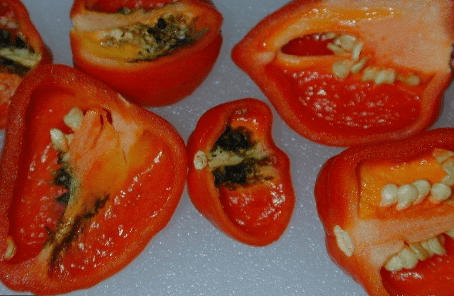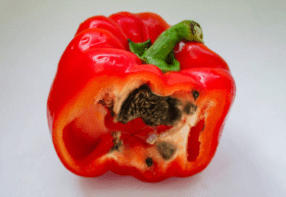Many people worry when they notice black seeds inside of peppers, especially when they are unsure of the cause. Not to worry. Everything has been found out in this article. To learn more, read the article in detail.

Inside-of-pepper blackening indicates rotting. Either the seeds’ demise or their failure to grow is responsible for blackening. When the black seeds are taken out, peppers are safe to consume. If there are indications of mold and blackening is obvious, pepper should be discarded.
Let’s find out more about peppers that have a black interior. Understanding the subtleties of the subject is crucial because eating healthily is essential for maintaining good health.
Table of Contents
What Causes a Peppers To Be Black Inside
In essence, there are three reasons why pepper may seem black on the interior.
First, peppers turn black when they spoil for whatever reason, including mold, etc.
Second, blackening reveals the pepper’s black seeds. The fresh seeds are white, indicating that the seeds must have died and turned black as a result. The seeds must therefore have turned black due to seed death.
The third reason is that the pepper’s seeds did not mature properly. The absence of seed development is thus the third cause of blackening inside peppers.
The three reasons mentioned above are mostly responsible for the peppers’ internal blackening.
Can You Eat Bell Peppers Or Hot Peppers With Black Spot Inside?
Bell peppers and hot peppers with black patches inside are edible.
Even if they have black spots, bell peppers are safe to consume. The black specks are simply a result of the peppers’ natural maturing process.
You can consume hot peppers that have black spots inside, but you should check to make sure the pepper isn’t spoilt first.
Therefore, it may be said that bell peppers or spicy peppers with black spots inside are safe to eat. The black spots are caused by a fungus that develops on the pepper’s skin, but they have no impact on the pepper’s flavor or nutritional content.
This means that blackening on bell peppers or hot peppers is safe to eat and poses no health risks.
Let’s take a brief detour: Have you ever seen a pepper that contained another pepper inside of it? Take a look at this video.
How to Tell When Peppers are Not Suitable to Eat
When determining if pepper is safe to eat, certain aspects are taken into account. It is not advised to consume peppers that have black seeds or to cultivate mold.
Pay attention to other diverse aspects that influence the quality of pepper in addition to these two.
What to look for when purchasing peppers of high quality:
- gentle touch
- deep recessed areas
- creased skin
- beside the stem or bloom end, fuzziness
- Peppers with holes and spots
- peppers with cracks
- expanding mold
- undesirable pepper odor
- the absence of moisture
These are a few elements that influence pepper quality. If the pepper is good or bad, they will tell you.
Are Peppers with Black Seeds Ok for Consumption
As long as there is no mold growing on or inside the peppers, peppers with black seeds are safe to eat. The seeds must only be taken out and thrown away.
Even if a pepper has black seeds, eating it is fine. Black seeds are the result of either dead seeds or seeds that did not grow properly.
Therefore, all that must be done is remove the rotten seeds and look for any mold growth. Peppers are safe to eat if it is not present.
Do not eat peppers if they have mold on them. Black-seeded peppers may give you a burning tongue feeling if you eat them.
Black-seeded peppers are frequently used in cuisine. On the other hand, peppers store their capsaicin in their seeds and skin.
It has been demonstrated that the chemical capsaicin provides a number of health advantages. An all-natural oxidant, capsaicin. It can aid in digestion issues, weight loss, and the battle against cancer cells.
Therefore, you can eat peppers with black seeds if you don’t mind the pepper’s flavor because they might taste bitter. You should avoid eating peppers with seeds if you have sensitive skin or a low pain threshold.
Additionally, black seeds are a sign of spoiled peppers. Therefore, it is best to remove the seeds before eating the pepper.
Are Black Spots Inside Peppers Mold?

It is untrue that black dots indicate the presence of mold growth. Due to blossom end rot, anthracnose, sunscald, or damp rot, the peppers are becoming black.
Black patches within peppers hence aren’t usually mold. The pepper seeds that were left inside while it was being cultivated may be the cause of the black markings.
Black marks could indicate that the seeds have died, which would result in spoiling.
How do Peppers Get Moldy Inside?
Pepper develops internal mold. However, knowing how moldy they are is crucial information. You can learn from this how to keep your peppers from going bad.
Fresh peppers will turn rotten if they come into contact with moisture or water. Pepper will mold if it is exposed to moisture and water for an extended period of time, lowering its quality.
– Are starting to rot or grow mold. You can cut out small parts spoiled or damaged parts, like you likely do for most veggies. … Along the stem or blossom’s end, there is fuzz
Why Do Peppers Get Moldy Inside?
Peppers with blemishes and stains
- peppers have cracks.
- appearing mold
- pepper’s pungent scent
insufficient moisture
The quality of pepper is influenced by a number of elements, including these. Whether the pepper is bad or not will be disclosed by them.
If there is no mold growing on or inside the peppers, peppers with black seeds can be consumed. The seeds must only be discarded after being removed.
Pepper consumption is acceptable, even if it contains seeds that are dark. Either the seeds were dead when they were planted, or they did not grow properly, which is why they turn black.
Should You Cut Off the Moldy Part of a Pepper?
Therefore, all that must be done is remove the rotten seeds and look for any mold that may be developing. Peppers are okay to eat if it’s not there.
Say no to pepper consumption if the peppers are moldy. There may be a burning feeling in the mouth if peppers with black seeds are ingested.
Frequently used in cooking are peppers with black seeds. Peppers store their capsaicin in their seeds and skin, though.
Are Moldy Seeds Dangerous?
There are several health advantages to the component capsaicin, it has been proven. A naturally occurring oxidant, capsaicin. It can aid in digestion issues, weight loss, and cancer cell elimination.
So long as you don’t mind the pepper’s flavor since black seeds might have a bitter taste, you can eat peppers with black seeds. Avoid eating peppers with seeds if you have sensitive skin or poor pain tolerance.
The Takeaway
The pepper has gone bad when the seeds are black. In this case, it is preferable to remove the seeds before eating the pepper.
That black dots indicate increasing mold is untrue, though. Blossom end rot, anthracnose, sunscald, or damp rot are all causes of the peppers becoming black.
Therefore, it is not usually mold that causes black spots inside peppers. The seeds that were left within the pepper during growth may be the cause of the black marks.
FAQ
Why is my Pepper black inside?
Fresh peppers will go rotten if they come in contact with moisture or water. Pepper will mold and lose its quality in whole if it is exposed to moisture and water for an extended period of time.
Can you eat a Pepper that is black?
The use of black pepper in cooking and as a supplement is usually regarded as safe, but because it can greatly increase the absorption of some medications, it should be used with caution. For the majority of individuals, however, adding black pepper to your diet is a simple method to enhance the flavor of your food and gain some health advantages.
Can you eat Pepper with black inside?
So long as you remove the rotting seeds from peppers with black seeds, you can still consume them! Fresh pepper seeds are those that are almost white in color; those that have become black have either died or never even begun to develop correctly.
